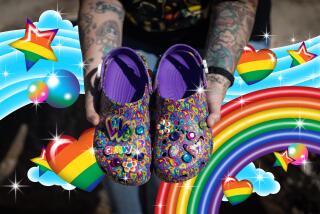Old and New: A Tricky Balancing Act
- Share via
LOUISVILLE, Ky. — Just off the food court at Mall St. Matthews, a shiny consumer palace in Louisville’s eastern suburbs, teens roam the roomy floor of a popular store and ponder painstaking fashion choices: Tank tops or baggy plaid? Jeans or cargo pants?
Not a bad demographic--especially for a 109-year-old company. Abercrombie & Fitch, which a decade ago was fading faster than the market for the arcane miscellany it sold, reinvented itself. In abandoning shotguns and tea sets for stylish clothes, the firm that once outfitted Hemingway found unprecedented nationwide prosperity and became a Wall Street darling.
“The merchandise we used to carry was a confusing combination,” says Lonnie Fogel, the company’s director of investor relations. “People knew our name, but they weren’t sure what Abercrombie was and what it wasn’t. So it was resurrected.”
Facing a late-1990s marketplace of dizzying intricacy and a fickle nation of consumers ravenous for the new and different, the companies behind some of America’s oldest, most familiar brand names are confronting a harsh reality: Tradition isn’t always enough.
Familiarity isn’t the problem. These are names long omnipresent on supermarket shelves, on clothing racks and in advertisements--names familiar to generations, the bedrocks of retail America: Campbell’s. Budweiser. Kodak. Fig Newtons. IBM. Ford. Coca-Cola. L.L. Bean. Ivory.
But a well-known name alone doesn’t ensure eternal success.
Consider the 146-year-old Levi Strauss Co., which earlier this year announced a new slate of 5,900 layoffs with a vow to retool its marketing to better suit what a company official called today’s “fast-food consumer.” Or, more drastically, Ipana, the ubiquitous 1950s toothpaste (“Brusha, brusha, brusha”) that is virtually forgotten today.
“American history is full of stories of companies that could not adjust to changing markets,” says Robert Sobel, a professor emeritus of business history at Hofstra University in Hempstead, N.Y.
This is hardly a secret. Venerable companies of all stripes have spent recent years devising new marketing tactics that blend consumer-comforting tradition with the progressiveness that’s crucial to continued success.
“We’re constantly being bombarded with the new. So suddenly something that’s been around for 100 years is a point of security,” says Jared Miller, co-author of “What Logos Do and How They Do It.” “As the world changes around us . . . those really become our family, our security, our identity. But there’s a reinterpretation by every era.”
So Kellogg Co.’s first new Frosted Flakes ad campaign in 14 years is a set of wink-nudge, documentary style commercials--but the star is still Tony the Tiger. So General Motors Corp. tries a new bunch of Chevy ads, but behind them is a time-tested slogan: “See the USA in your Chevrolet.” And so L.L. Bean jazzes up its catalog, goes online and introduces a new women’s clothing line--while carefully maintaining its brand’s New England image.
“You take the classic appeal, and you take it to another generation,” says Rich Donaldson, spokesman for the 87-year-old company.
Another approach is “co-branding,” which combines the power of two brand names to enliven a product. Doritos has marketed a Taco Bell-flavored nacho chip. And Slim Jim offers a meat snack flavored with the popular Tabasco pepper sauce, which has also “co-branded” with Heinz Ketchup and A-1 Steak Sauce.
Tabasco’s continued success in the pepper-sauce market, in fact, exemplifies the balance between looking back and looking forward.
Its advertising is careful to sound traditional themes (Civil War-era family business, down-home Louisiana island, pepper mash aged in white-oak barrels), but it also markets itself as cutting-edge and trendy (Tabasco neckties, Cajun cooking festivals, a Super Bowl ad featuring a mosquito that explodes after sucking the blood of a Tabasco lover).
What’s more, a popular drink on college campuses, the Prairie Fire, combines a shot of tequila with a splash of Tabasco. A trendier variation blends Tabasco with cinnamon schnapps--something company President Paul C.P. McIlhenny learned with some bemusement in a rural Louisiana oyster bar last month. He didn’t like drinking it, but he appreciated what it meant--that young people consider Tabasco cool.
“There are all sorts of balancing acts needed in marketing,” McIlhenny says. “Do you go after the Avery Island story--’aged in white oak barrels?’ Or do you go for the exploding mosquito because heat is in? You have to do both.”
It comes down to the most basic business practice of all: Know your market. Robert McMath, a marketing guru and consultant who runs the New Products Showcase and Learning Center in Ithaca, N.Y, says many brands make missteps nonetheless.
“Alka-Seltzer, for a while, went out of the plop-plop fizz-fizz business and tried to out-Advil Advil. In the end, they completely confused who they are,” he says. And Kodak “let Fuji run away with the image market.”
“But look at Campbell’s soup,” McMath says. “They’re constantly reinventing themselves. They’re doing research, they’re coming up with new slogans.” One recent ad features a working mother choosing Campbell’s soup over freezer dinners for her child, combining the comfort-food tradition with the latter-day concern of hurried meals.
Thus do brands avoid being cast into the dustbin of product history: by maintaining that intricate balance between yesterday and today, between tradition and trend, between playing it safe and going outside the box.
“The danger is when . . . the president [(of a company] says, ‘My father came up with that product and it’s a monument to his memory and we’re not going to get rid of it as long as I’m here.’ And of course he’s not there four years later,” says Sobel, the business historian. “If you’re wedded to the past, you’re going to fail.”
More to Read
Inside the business of entertainment
The Wide Shot brings you news, analysis and insights on everything from streaming wars to production — and what it all means for the future.
You may occasionally receive promotional content from the Los Angeles Times.










